2008 Seat Ibiza 5D fuel pressure
[x] Cancel search: fuel pressurePage 201 of 260
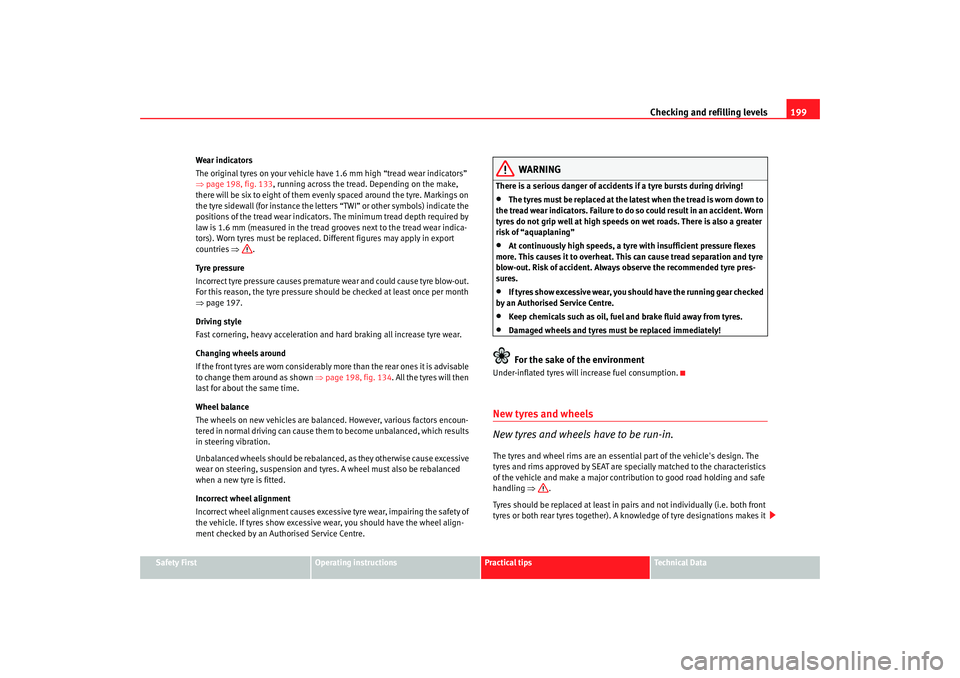
Checking and refilling levels199
Safety First
Operating instructions
Practical tips
Te c h n i c a l D a t a
Wear indicators
The original tyres on your vehicle have 1.6 mm high “tread wear indicators”
⇒
page 198, fig. 133 , running across the tread. Depending on the make,
there will be six to eight of them evenly spaced around the tyre. Markings on
the tyre sidewall (for instance the letters “TWI” or other symbols) indicate the
positions of the tread wear indicators. The minimum tread depth required by
law is 1.6 mm (measured in the tread grooves next to the tread wear indica-
tors). Worn tyres must be replaced. Different figures may apply in export
countries ⇒.
Tyre pressure
Incorrect tyre pressure causes premature wear and could cause tyre blow-out.
For this reason, the tyre pressure should be checked at least once per month
⇒ page 197.
Driving style
Fast cornering, heavy acceleration and hard braking all increase tyre wear.
Changing wheels around
If the front tyres are worn considerably more than the rear ones it is advisable
to change them around as shown ⇒page 198, fig. 134 . All the tyres will then
last for about the same time.
Wheel balance
The wheels on new vehicles are balanced. However, various factors encoun-
tered in normal driving can cause them to become unbalanced, which results
in steering vibration.
Unbalanced wheels should be rebalanced, as they otherwise cause excessive
wear on steering, suspension and tyres. A wheel must also be rebalanced
when a new tyre is fitted.
Incorrect wheel alignment
Incorrect wheel alignment causes excessive tyre wear, impairing the safety of
the vehicle. If tyres show excessive wear, you should have the wheel align-
ment checked by an Authorised Service Centre.
WARNING
There is a serious danger of accidents if a tyre bursts during driving!•
The tyres must be replaced at the latest when the tread is worn down to
the tread wear indicators. Failure to do so could result in an accident. Worn
tyres do not grip well at high speeds on wet roads. There is also a greater
risk of “aquaplaning”
•
At continuously high speeds, a tyre with insufficient pressure flexes
more. This causes it to overheat. This can cause tread separation and tyre
blow-out. Risk of accident. Always observe the recommended tyre pres-
sures.
•
If tyres show excessive wear, you should have the running gear checked
by an Authorised Service Centre.
•
Keep chemicals such as oil, fuel and brake fluid away from tyres.
•
Damaged wheels and tyres must be replaced immediately!For the sake of the environment
Under-inflated tyres will increase fuel consumption.New tyres and wheels
New tyres and wheels have to be run-in.The tyres and wheel rims are an essential part of the vehicle's design. The
tyres and rims approved by SEAT are specially matched to the characteristics
of the vehicle and make a major contribution to good road holding and safe
handling ⇒.
Tyres should be replaced at least in pair s and not individually (i.e. both front
tyres or both rear tyres together). A knowledge of tyre designations makes it
Ibiza250_angles Seite 199 Dienstag, 5. August 2008 1:11 13
Page 203 of 260
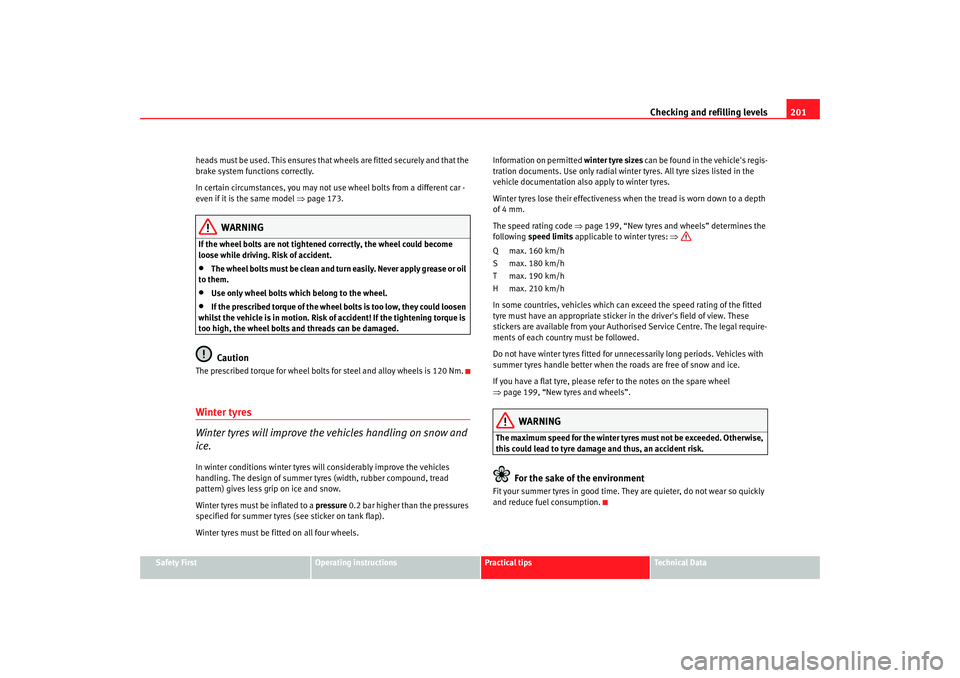
Checking and refilling levels201
Safety First
Operating instructions
Practical tips
Te c h n i c a l D a t a
heads must be used. This ensures that wheels are fitted securely and that the
brake system functions correctly.
In certain circumstances, you may not
use wheel bolts from a different car -
even if it is the same model ⇒page 173.
WARNING
If the wheel bolts are not tightened correctly, the wheel could become
loose while driving. Risk of accident.•
The wheel bolts must be clean and turn easily. Never apply grease or oil
to them.
•
Use only wheel bolts which belong to the wheel.
•
If the prescribed torque of the wheel bolts is too low, they could loosen
whilst the vehicle is in motion. Risk of accident! If the tightening torque is
too high, the wheel bolts and threads can be damaged.Caution
The prescribed torque for wheel bolts for steel and alloy wheels is 120 Nm.Winter tyres
Winter tyres will improve the vehicles handling on snow and
ice.In winter conditions winter tyres will considerably improve the vehicles
handling. The design of summer tyre s (width, rubber compound, tread
pattern) gives less grip on ice and snow.
Winter tyres must be inflated to a pressure 0.2 bar higher than the pressures
specified for summer tyres (see sticker on tank flap).
Winter tyres must be fitted on all four wheels. Information on permitted
winter tyre sizes can be found in the vehicle's regis-
tration documents. Use only radial winter tyres. All tyre sizes listed in the
vehicle documentation also apply to winter tyres.
Winter tyres lose their effectiveness when the tread is worn down to a depth
of 4 mm.
The speed rating code ⇒page 199, “New tyres and wheels” determines the
following speed limits applicable to winter tyres: ⇒
Q max. 160 km/h
S max. 180 km/h
T max. 190 km/h
H max. 210 km/h
In some countries, vehicles which can exceed the speed rating of the fitted
tyre must have an appropriate sticker in the driver's field of view. These
stickers are available from your Authorised Service Centre. The legal require-
ments of each country must be followed.
Do not have winter tyres fitted for unnecessarily long periods. Vehicles with
summer tyres handle better when the roads are free of snow and ice.
If you have a flat tyre, please refer to the notes on the spare wheel
⇒ page 199, “New tyres and wheels”.
WARNING
The maximum speed for the winter tyres must not be exceeded. Otherwise,
this could lead to tyre damage and thus, an accident risk.
For the sake of the environment
Fit your summer tyres in good time. They are quieter, do not wear so quickly
and reduce fuel consumption.
Ibiza250_angles Seite 201 Dienstag, 5. August 2008 1:11 13
Page 231 of 260

If and when229
Safety First
Operating instructions
Practical tips
Te c h n i c a l D a t a
Towing and tow-startingTo w - s t a r t i n g *
The use of jump leads is preferable to tow-starting.We recommend that you do not tow-start your vehicle. Jump-starting
is preferable ⇒page 226.
However, if your vehicle has to be tow-started:
–Engage the 2
nd or the 3
rd gear.
– Keep the clutch pressed down.
– Switch the ignition on.
– Once both vehicles are mo ving, release the clutch.
– As soon as the engine starts, press the clutch and move the gear lever into neutral. This helps to prevent driving into the towing
vehicle.
WARNING
The risk of accidents is high when tow-starting. The vehicle being towed
can easily collide with the towing vehicle.
Caution
When tow-starting, fuel could enter the catalytic converter and damage it.
CommentsPlease observe the following points if you use a tow-rope:
Notes for the driver of the towing vehicle
– Drive slowly at first until the tow-rope is taut. Then accelerate gradually.
– Begin and change gears cautiously. If you are driving an auto- matic vehicle, accelerate gently.
– Remember that the brake servo and power steering are not working in the vehicle you are towing. Brake earlier than you
would normally, but with a more gentle pressure on the brake.
Notes for the driver of the towed vehicle
– Ensure that the tow-rope remains taut at all times when towing.Tow-rope or tow-bar
It is easier and safer to tow a vehicle with a tow-bar. You should only use a
tow-rope if you do not have a tow-bar.
A tow-rope should be slightly elastic to reduce the loading on both vehicles.
It is advisable to use a tow-rope made of synthetic fibre or similarly elastic
material.
Attach the tow-rope or the tow-bar only to the towing eyes provided or a
towing bracket.
Driving style
Towing requires some experience, especially when using a tow-rope. Both
drivers should be familiar with the technique required for towing. Inexperi-
enced drivers should not attempt to tow-start or tow away another vehicle.
Ibiza250_angles Seite 229 Dienstag, 5. August 2008 1:11 13
Page 238 of 260
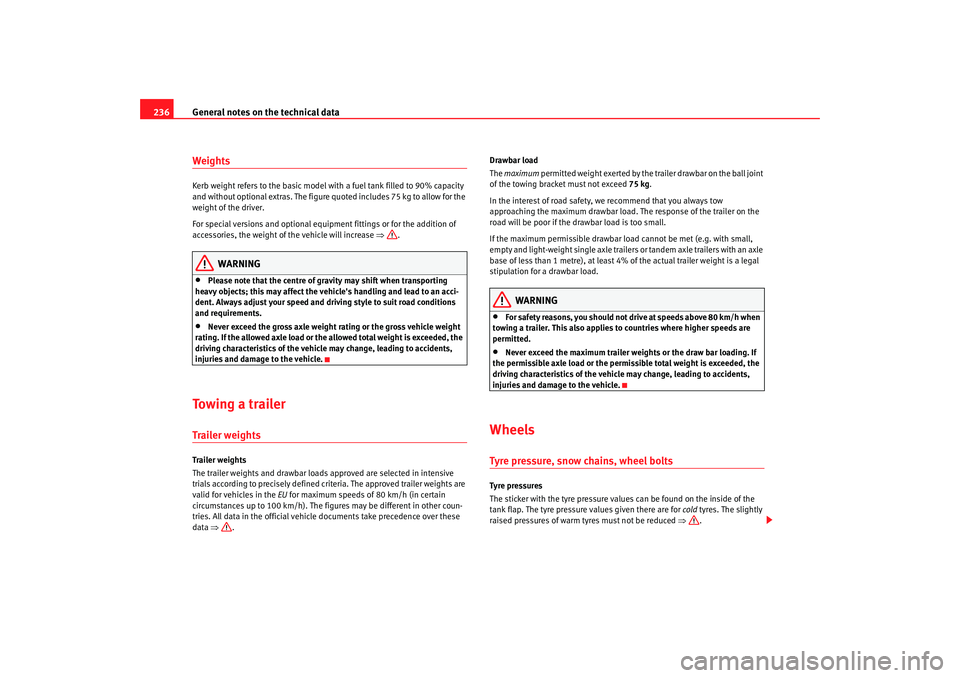
General notes on the technical data
236WeightsKerb weight refers to the basic model with a fuel tank filled to 90% capacity
and without optional extras. The figure quoted includes 75 kg to allow for the
weight of the driver.
For special versions and optional equipment fittings or for the addition of
accessories, the weight of the vehicle will increase ⇒.
WARNING
•
Please note that the centre of gravity may shift when transporting
heavy objects; this may affect the vehi cle's handling and lead to an acci-
dent. Always adjust your speed and dr iving style to suit road conditions
and requirements.
•
Never exceed the gross axle weight rating or the gross vehicle weight
rating. If the allowed axle load or the allowed total weight is exceeded, the
driving characteristics of the vehicle may change, leading to accidents,
injuries and damage to the vehicle.
To w i n g a t r a i l e rTrailer weightsTrailer weights
The trailer weights and drawbar loads approved are selected in intensive
trials according to precisely defined criteria. The approved trailer weights are
valid for vehicles in the EU for maximum speeds of 80 km/h (in certain
circumstances up to 100 km/h). The figu res may be different in other coun-
tries. All data in the official vehicl e documents take precedence over these
data ⇒ . Drawbar load
The
maximum permitted weight exerted by the trailer drawbar on the ball joint
of the towing bracket must not exceed 75 kg.
In the interest of road safety, we recommend that you always tow
approaching the maximum drawbar load. The response of the trailer on the
road will be poor if th e drawbar load is too small.
If the maximum permissible drawbar load cannot be met (e.g. with small,
empty and light-weight single axle trailers or tandem axle trailers with an axle
base of less than 1 metre), at least 4% of the actual trailer weight is a legal
stipulation for a drawbar load.
WARNING
•
For safety reasons, you should not drive at speeds above 80 km/h when
towing a trailer. This also applies to countries where higher speeds are
permitted.
•
Never exceed the maximum trailer weights or the draw bar loading. If
the permissible axle load or the perm issible total weight is exceeded, the
driving characteristics of the vehicle may change, leading to accidents,
injuries and damage to the vehicle.
WheelsTyre pressure, snow chains, wheel boltsTyre pressures
The sticker with the tyre pressure values can be found on the inside of the
tank flap. The tyre pressure values given there are for cold tyres. The slightly
raised pressures of warm tyres must not be reduced ⇒.
Ibiza250_angles Seite 236 Dienstag, 5. August 2008 1:11 13
Page 249 of 260
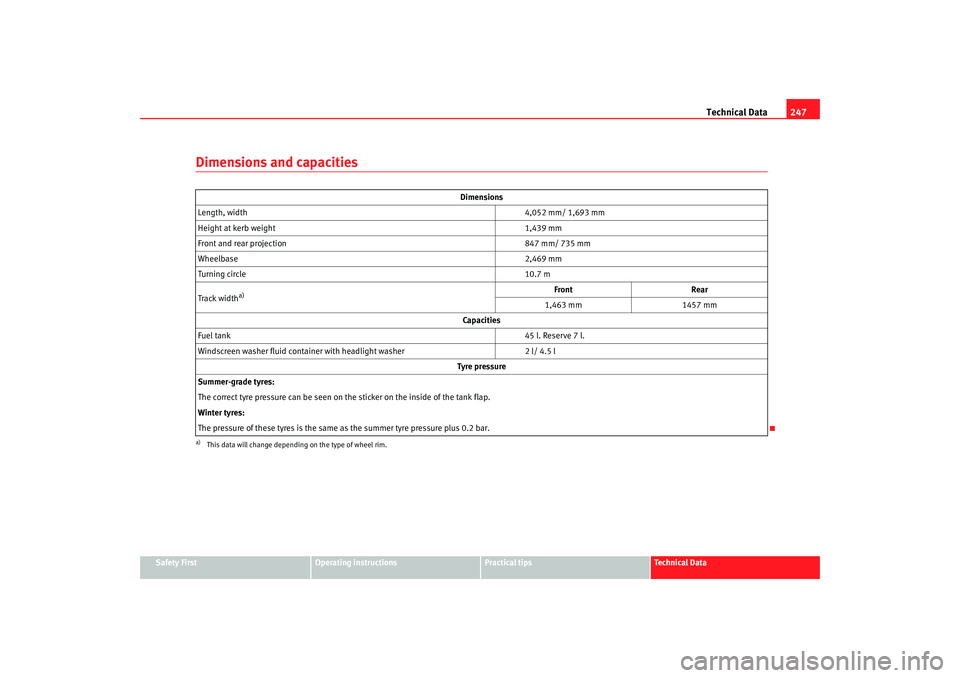
Technical Data247
Safety First
Operating instructions
Practical tips
Te c h n i c a l D a t a
Dimensions and capacities
Dimensions
Length, width 4,052 mm/ 1,693 mm
Height at kerb weight 1,439 mm
Front and rear projection 847 mm/ 735 mm
Wheelbase 2,469 mm
Turning circle 10.7 m
Track width
a)
a)This data will change depending on the type of wheel rim.
Front Rear
1,463 mm 1457 mm
Capacities
Fuel tank 45 l. Reserve 7 l.
Windscreen washer fluid container with headlight washer 2 l/ 4.5 l
Tyre pressure
Summer-grade tyres:
The correct tyre pressure can be seen on the sticker on the inside of the tank flap.
Winter tyres:
The pressure of these tyres is the same as the summer tyre pressure plus 0.2 bar.
Ibiza250_angles Seite 247 Dienstag, 5. August 2008 1:11 13
Page 254 of 260
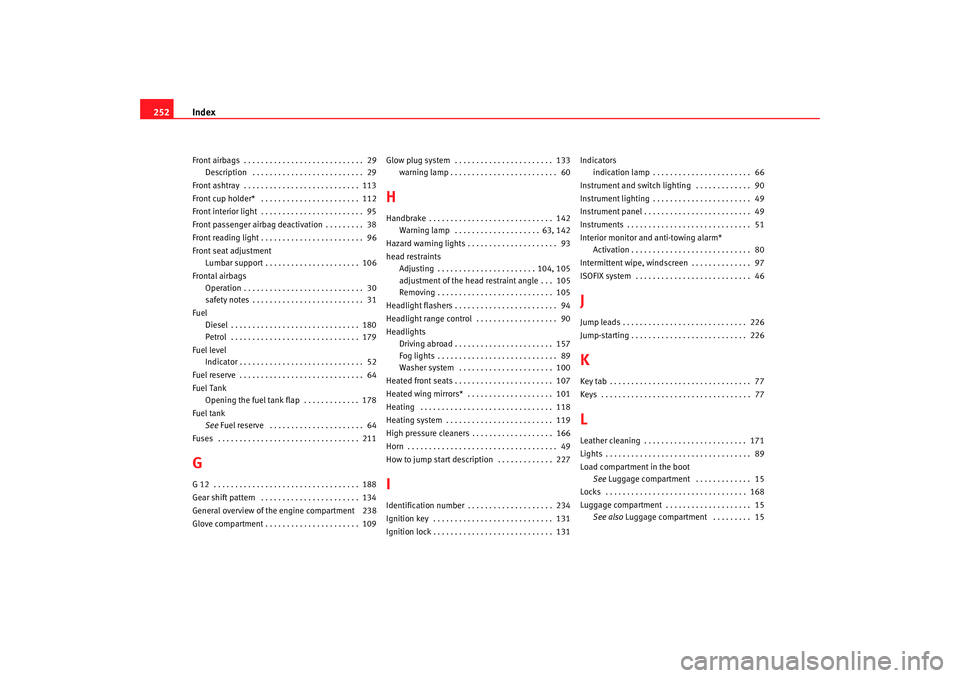
Index
252Front airbags . . . . . . . . . . . . . . . . . . . . . . . . . . . . 29
Description . . . . . . . . . . . . . . . . . . . . . . . . . . 29
Front ashtray . . . . . . . . . . . . . . . . . . . . . . . . . . . 113
Front cup holder* . . . . . . . . . . . . . . . . . . . . . . . 112
Front interior light . . . . . . . . . . . . . . . . . . . . . . . . 95
Front passenger airbag deactivation . . . . . . . . . 38
Front reading light . . . . . . . . . . . . . . . . . . . . . . . . 96
Front seat adjustment Lumbar support . . . . . . . . . . . . . . . . . . . . . . 106
Frontal airbags Operation . . . . . . . . . . . . . . . . . . . . . . . . . . . . 30
safety notes . . . . . . . . . . . . . . . . . . . . . . . . . . 31
Fuel Diesel . . . . . . . . . . . . . . . . . . . . . . . . . . . . . . 180
Petrol . . . . . . . . . . . . . . . . . . . . . . . . . . . . . . 179
Fuel level Indicator . . . . . . . . . . . . . . . . . . . . . . . . . . . . . 52
Fuel reserve . . . . . . . . . . . . . . . . . . . . . . . . . . . . . 64
Fuel Tank Opening the fuel tank flap . . . . . . . . . . . . . 178
Fuel tank See Fuel reserve . . . . . . . . . . . . . . . . . . . . . . 64
Fuses . . . . . . . . . . . . . . . . . . . . . . . . . . . . . . . . . 211GG 12 . . . . . . . . . . . . . . . . . . . . . . . . . . . . . . . . . . 188
Gear shift pattern . . . . . . . . . . . . . . . . . . . . . . . 134
General overview of the engine compartment 238
Glove compartment . . . . . . . . . . . . . . . . . . . . . . 109 Glow plug system . . . . . . . . . . . . . . . . . . . . . . . 133
warning lamp . . . . . . . . . . . . . . . . . . . . . . . . . 60
HHandbrake . . . . . . . . . . . . . . . . . . . . . . . . . . . . . 142Warning lamp . . . . . . . . . . . . . . . . . . . . 63, 142
Hazard warning lights . . . . . . . . . . . . . . . . . . . . . 93
head restraints Adjusting . . . . . . . . . . . . . . . . . . . . . . . 104, 105
adjustment of the head restraint angle . . . 105
Removing . . . . . . . . . . . . . . . . . . . . . . . . . . . 105
Headlight flashers . . . . . . . . . . . . . . . . . . . . . . . . 94
Headlight range control . . . . . . . . . . . . . . . . . . . 90
Headlights Driving abroad . . . . . . . . . . . . . . . . . . . . . . . 157
Fog lights . . . . . . . . . . . . . . . . . . . . . . . . . . . . 89
Washer system . . . . . . . . . . . . . . . . . . . . . . 100
Heated front seats . . . . . . . . . . . . . . . . . . . . . . . 107
Heated wing mirrors* . . . . . . . . . . . . . . . . . . . . 101
Heating . . . . . . . . . . . . . . . . . . . . . . . . . . . . . . . 118
Heating system . . . . . . . . . . . . . . . . . . . . . . . . . 119
High pressure cleaners . . . . . . . . . . . . . . . . . . . 166
Horn . . . . . . . . . . . . . . . . . . . . . . . . . . . . . . . . . . . 49
How to jump start description . . . . . . . . . . . . . 227IIdentification number . . . . . . . . . . . . . . . . . . . . 234
Ignition key . . . . . . . . . . . . . . . . . . . . . . . . . . . . 131
Ignition lock . . . . . . . . . . . . . . . . . . . . . . . . . . . . 131 Indicators
indication lamp . . . . . . . . . . . . . . . . . . . . . . . 66
Instrument and switch lighting . . . . . . . . . . . . . 90
Instrument lighting . . . . . . . . . . . . . . . . . . . . . . . 49
Instrument panel . . . . . . . . . . . . . . . . . . . . . . . . . 49
Instruments . . . . . . . . . . . . . . . . . . . . . . . . . . . . . 51
Interior monitor and anti-towing alarm* Activation . . . . . . . . . . . . . . . . . . . . . . . . . . . . 80
Intermittent wipe, windscreen . . . . . . . . . . . . . . 97
ISOFIX system . . . . . . . . . . . . . . . . . . . . . . . . . . . 46
JJump leads . . . . . . . . . . . . . . . . . . . . . . . . . . . . . 226
Jump-starting . . . . . . . . . . . . . . . . . . . . . . . . . . . 226KKey tab . . . . . . . . . . . . . . . . . . . . . . . . . . . . . . . . . 77
Keys . . . . . . . . . . . . . . . . . . . . . . . . . . . . . . . . . . . 77LLeather cleaning . . . . . . . . . . . . . . . . . . . . . . . . 171
Lights . . . . . . . . . . . . . . . . . . . . . . . . . . . . . . . . . . 89
Load compartment in the boot See Luggage compartment . . . . . . . . . . . . . 15
Locks . . . . . . . . . . . . . . . . . . . . . . . . . . . . . . . . . 168
Luggage compartment . . . . . . . . . . . . . . . . . . . . 15 See also Luggage compartment . . . . . . . . . 15
Ibiza250_angles Seite 252 Dienstag, 5. August 2008 1:11 13
Page 257 of 260
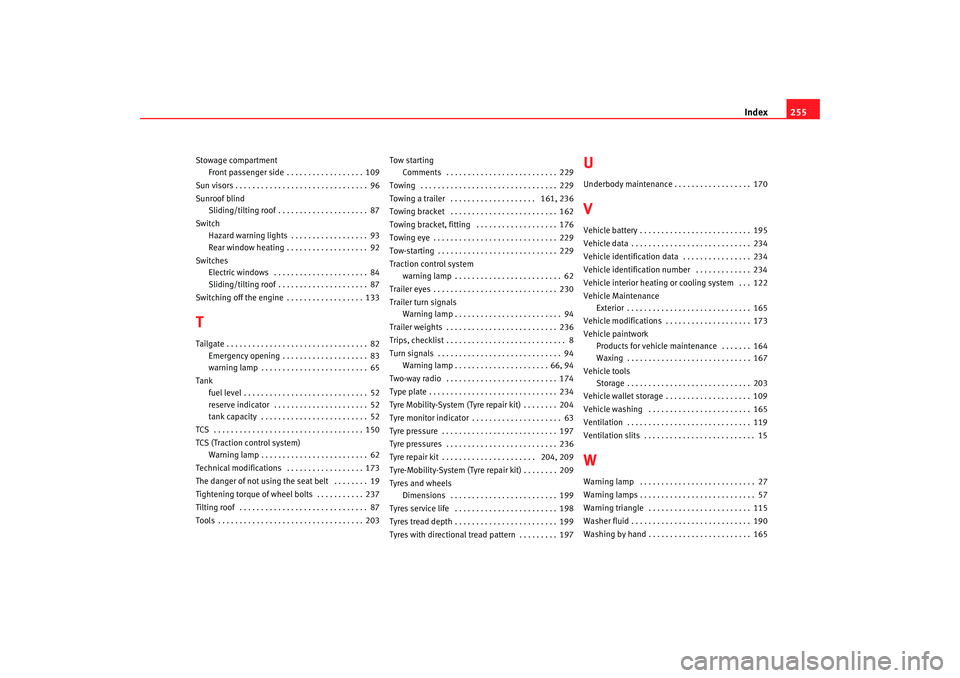
Index255
Stowage compartment
Front passenger side . . . . . . . . . . . . . . . . . . 109
Sun visors . . . . . . . . . . . . . . . . . . . . . . . . . . . . . . . 96
Sunroof blind Sliding/tilting roof . . . . . . . . . . . . . . . . . . . . . 87
Switch Hazard warning lights . . . . . . . . . . . . . . . . . . 93
Rear window heating . . . . . . . . . . . . . . . . . . . 92
Switches Electric windows . . . . . . . . . . . . . . . . . . . . . . 84
Sliding/tilting roof . . . . . . . . . . . . . . . . . . . . . 87
Switching off the engine . . . . . . . . . . . . . . . . . . 133TTailgate . . . . . . . . . . . . . . . . . . . . . . . . . . . . . . . . . 82 Emergency opening . . . . . . . . . . . . . . . . . . . . 83
warning lamp . . . . . . . . . . . . . . . . . . . . . . . . . 65
Tank fuel level . . . . . . . . . . . . . . . . . . . . . . . . . . . . . 52
reserve indicator . . . . . . . . . . . . . . . . . . . . . . 52
tank capacity . . . . . . . . . . . . . . . . . . . . . . . . . 52
TCS . . . . . . . . . . . . . . . . . . . . . . . . . . . . . . . . . . . 150
TCS (Traction control system) Warning lamp . . . . . . . . . . . . . . . . . . . . . . . . . 62
Technical modifications . . . . . . . . . . . . . . . . . . 173
The danger of not using the seat belt . . . . . . . . 19
Tightening torque of wheel bolts . . . . . . . . . . . 237
Tilting roof . . . . . . . . . . . . . . . . . . . . . . . . . . . . . . 87
Tools . . . . . . . . . . . . . . . . . . . . . . . . . . . . . . . . . . 203 Tow starting
Comments . . . . . . . . . . . . . . . . . . . . . . . . . . 229
Towing . . . . . . . . . . . . . . . . . . . . . . . . . . . . . . . . 229
Towing a trailer . . . . . . . . . . . . . . . . . . . . 161, 236
Towing bracket . . . . . . . . . . . . . . . . . . . . . . . . . 162
Towing bracket, fitting . . . . . . . . . . . . . . . . . . . 176
Towing eye . . . . . . . . . . . . . . . . . . . . . . . . . . . . . 229
Tow-starting . . . . . . . . . . . . . . . . . . . . . . . . . . . . 229
Traction control system warning lamp . . . . . . . . . . . . . . . . . . . . . . . . . 62
Trailer eyes . . . . . . . . . . . . . . . . . . . . . . . . . . . . . 230
Trailer turn signals Warning lamp . . . . . . . . . . . . . . . . . . . . . . . . . 94
Trailer weights . . . . . . . . . . . . . . . . . . . . . . . . . . 236
Trips, checklist . . . . . . . . . . . . . . . . . . . . . . . . . . . . 8
Turn signals . . . . . . . . . . . . . . . . . . . . . . . . . . . . . 94 Warning lamp . . . . . . . . . . . . . . . . . . . . . . 66, 94
Two-way radio . . . . . . . . . . . . . . . . . . . . . . . . . . 174
Type plate . . . . . . . . . . . . . . . . . . . . . . . . . . . . . . 234
Tyre Mobility-System (Tyre repair kit) . . . . . . . . 204
Tyre monitor indicator . . . . . . . . . . . . . . . . . . . . . 63
Tyre pressure . . . . . . . . . . . . . . . . . . . . . . . . . . . 197
Tyre pressures . . . . . . . . . . . . . . . . . . . . . . . . . . 236
Tyre repair kit . . . . . . . . . . . . . . . . . . . . . . 204, 209
Tyre-Mobility-System (Tyre repair kit) . . . . . . . . 209
Tyres and wheels Dimensions . . . . . . . . . . . . . . . . . . . . . . . . . 199
Tyres service life . . . . . . . . . . . . . . . . . . . . . . . . 198
Tyres tread depth . . . . . . . . . . . . . . . . . . . . . . . . 199
Tyres with directional tread pattern . . . . . . . . . 197
UUnderbody maintenance . . . . . . . . . . . . . . . . . . 170VVehicle battery . . . . . . . . . . . . . . . . . . . . . . . . . . 195
Vehicle data . . . . . . . . . . . . . . . . . . . . . . . . . . . . 234
Vehicle identification data . . . . . . . . . . . . . . . . 234
Vehicle identification number . . . . . . . . . . . . . 234
Vehicle interior heating or cooling system . . . 122
Vehicle Maintenance Exterior . . . . . . . . . . . . . . . . . . . . . . . . . . . . . 165
Vehicle modifications . . . . . . . . . . . . . . . . . . . . 173
Vehicle paintwork Products for vehicle maintenance . . . . . . . 164
Waxing . . . . . . . . . . . . . . . . . . . . . . . . . . . . . 167
Vehicle tools Storage . . . . . . . . . . . . . . . . . . . . . . . . . . . . . 203
Vehicle wallet storage . . . . . . . . . . . . . . . . . . . . 109
Vehicle washing . . . . . . . . . . . . . . . . . . . . . . . . 165
Ventilation . . . . . . . . . . . . . . . . . . . . . . . . . . . . . 119
Ventilation slits . . . . . . . . . . . . . . . . . . . . . . . . . . 15WWarning lamp . . . . . . . . . . . . . . . . . . . . . . . . . . . 27
Warning lamps . . . . . . . . . . . . . . . . . . . . . . . . . . . 57
Warning triangle . . . . . . . . . . . . . . . . . . . . . . . . 115
Washer fluid . . . . . . . . . . . . . . . . . . . . . . . . . . . . 190
Washing by hand . . . . . . . . . . . . . . . . . . . . . . . . 165
Ibiza250_angles Seite 255 Dienstag, 5. August 2008 1:11 13